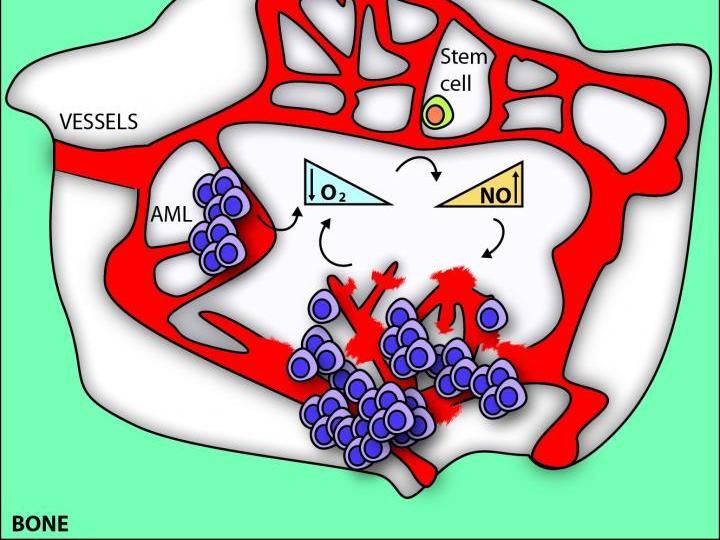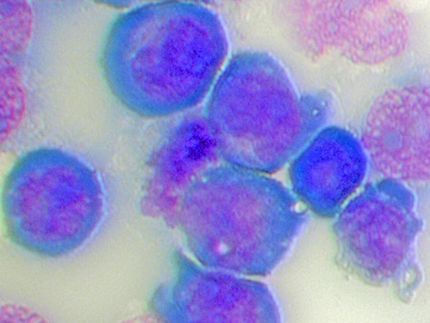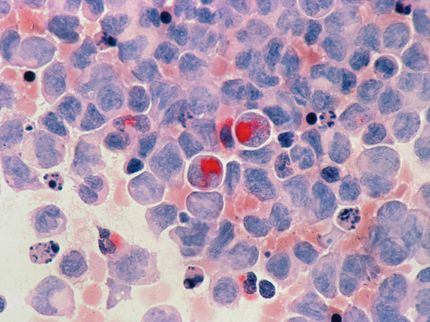Chemo-boosting drug discovered for leukemia
drugs developed to treat heart and blood vessel problems could be used in combination with chemotherapy to treat an aggressive form of adult leukemia, new research led by the Francis Crick Institute reveals.

AML cells reduce oxygen levels, causing increased NO production, which causes blood vessels to leak. Blocking NO restores leakiness and boosts the number of stem cells.
Diana Passaro
In a study published in Cancer Cell, researchers at the Francis Crick Institute, King's College London and Barts Cancer Institute discovered that acute myeloid leukemia (AML) - the most common acute leukemia affecting adults - causes bone marrow to 'leak' blood, preventing chemotherapy from being delivered properly. Drugs that reversed bone marrow leakiness boosted the effect of chemotherapy in mice and human tissue, providing a possible new combination therapy for AML patients.
"We found that the cancer was damaging the walls of blood vessels responsible for delivering oxygen, nutrients, and chemotherapy. When we used drugs to stop the leaks in mice, we were able to kill the cancer using conventional chemotherapy," says Diana Passaro, first author of the paper and researcher at the Francis Crick Institute.
As the drugs are already in clinical trials for other conditions, it is hoped that they could be given the green light for AML patients in the future.
AML is relatively rare - approximately 2,600 people are diagnosed in the UK each year - but as it mainly affects people over 65, prevalence is likely to increase with an ageing population. It is a particularly aggressive cancer, with fewer than a quarter of patients living for five years after diagnosis.* Chemotherapy resistance and relapse are a major problem in treating the disease.
To study how AML affects bone marrow, the team injected mice with bone marrow from AML patients. Later, they compared their bone marrow with healthy mice using a technique called intravital microscopy that allows you to see biological processes in live animals. They found that pre-loaded fluorescent dyes leaked out of the bone marrow blood vessels in AML mice, but not healthy mice.
Next, the team tried to understand what caused the bone marrow in AML mice to become leaky by studying molecular changes in the cells lining the blood vessels. They found that they were oxygen-starved compared to healthy mice, likely because AML cells use up a lot of oxygen in the surrounding tissue. In response to a reduction in oxygen, there was an increase in nitric oxide (NO) production - a molecule that usually alerts the body to areas of low oxygen.
As NO is a muscle relaxant, the team suspected that it might be causing bone marrow leakiness by loosening the tight seams between cells, allowing blood to escape through the gaps. By blocking the production of NO using drugs, the team were able to restore bone marrow blood vessels in AML mice, preventing blood from leaking out. Mice given NO blockers in combination with chemotherapy had much slower leukemia progression and stayed in remission much longer than mice given chemotherapy alone.
"When the vessels are leaky, bone marrow blood flow becomes irregular and leukemia cells can easily find places to hide and escape chemotherapy drugs," says Diana. "Leaky vessels also prevent oxygen reaching parts of the bone marrow, which contributes to more NO production and leakiness."
"By restoring normal blood flow with NO blockers, we ensure that chemotherapy actually reaches the leukemia cells, so that therapy works properly."
In addition to ensuring that chemotherapy drugs reach their targets, the team also found that NO blockers boosted the number of stem cells in the bone marrow. This may also improve treatment outcomes by helping healthy cells to out-compete cancerous cells.
The team also found that bone marrow biopsies from AML patients had higher NO levels than those from healthy donors, and failure to reduce NO levels was associated with chemotherapy failure.
"Our findings suggest that it might be possible to predict how well people with AML will respond to chemotherapy," says Dominique Bonnet, senior author of the paper and Group Leader at the Francis Crick Institute.
"We've uncovered a biological marker for this type of leukemia as well as a possible drug target. The next step will be clinical trials to see if NO blockers can help AML patients as much as our pre-clinical experiments suggest."























































